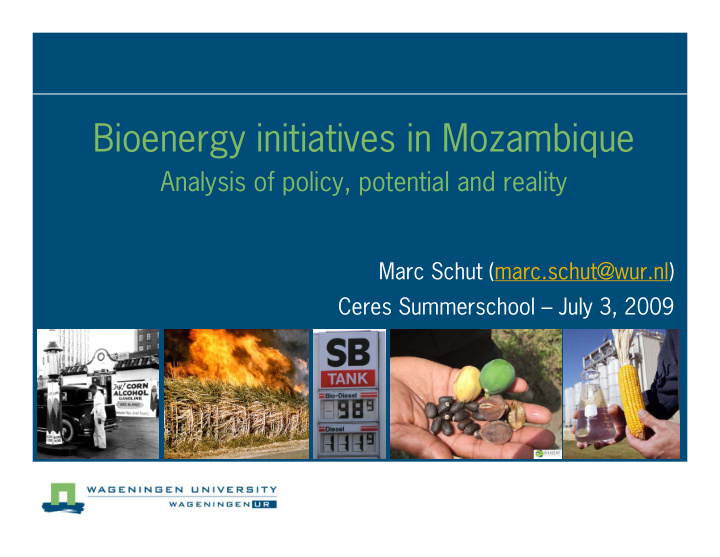



Bioenergy initiatives in Mozambique Analysis of policy, potential and reality Marc Schut (marc.schut@wur.nl) Ceres Summerschool – July 3, 2009
Country statistics Land area: 801,590 million km 2 Total population: 20 million Arable land: 36 million ha Arable land in use: 4-5 million ha GDP: Annual growth of 7% Contribution agriculture to GDP: 23% Agricultural sector: 3.2 million smallholder households (representing 85% of total population) and 400 commercial farmers Agricultural extension: 1 per 1.067 households Average land per family: 1.4 ha Sources: FAO and Worldbank Factsheets Google Earth
Mozambique and its ‘abundance’ “Mozambique has unexploited natural resources and abundant labor…” “Water resources, in the form of multiple rivers, are also abundant and underexploited” “Only 9% is of the arable land is under cultivation, abundant labor and water are available to produce bio- fuels without threatening food security…” Sources: Wilson and Abiola, 2003 IFPRI, 2008 Mozambican Ministry of Energy, 2007
Objective Bio-physical potential Impact Policy & legal framework Social and economic drivers
Bioenergy developments in Africa Promising prospects for bioenergy production in Africa Land, water and labour Competitive production Wave of private investors High uncertainty (Jatropha) Sustainability debate Financial crisis Source: Google Earth
Mozambique responds The consequences for African countries: Ethical issues: EU imposes criteria on Africa “Unnecessarily restrictive” and “illegal and discriminating” development countries access to world market Mozambican governments not against sustainable development Sustainability principles that fit the Mozambican reality Approved Biofuel Policy March, 2009 Source: BusinessGreen, 2008
Policy The government decided to embark upon the promotion of biofuels production to: 1. Respond to National Poverty Alleviation Agenda , especially in rural areas 2. Provide a response to high, unpredictable and volatile oil prices on the world markets Source: Salvador Namburete during PABO-meeting, March 2009 National Biofuel Strategy, 2009
Potential Distribution of land suitable for rain-fed agriculture Niassa, Zambézia, Tete, But what does reality Nampula and Cabo Delgado Manica and Sofala show us? Maputo, Gaza, Inhambane Regional biomass annual production potential in Mozambique (2015) Source: Batidzirai et al., 2006
Analysis of impact Heterogeneity of biofuel projects Current bioenergy initiatives situated around existing good infrastructure Zoning and biophysical potential are not (yet) decisive drivers In the current situation the government’s objectives are unlikely to be achieved: Investors do not focus on rural areas Commercial projects prefer premium markets in EU, rather than supplying domestic or local markets
Biophysical drivers Reality: Assumed abundance of land, water and labor does not respect the complexity of farming in Africa Uncertainty about the impact of biomass cultivation (pests and viruses especially with Jatropha) and land-use change We need to: Respect tangible constraints that limit biophysical potential such as labor availability, extension services, suitable farming systems and infrastructure, absence of draught power, access to (drinking) water, HIV-AIDS, food-shortage, malnutrition, etc.
Policy and legal drivers Reality: Who is ‘steering the drivers’ (conflicts of scale) Controversy between standardization/ generalization and the heterogeneity of bioenergy projects in the Mozambican reality We need: Diversified (policy) strategies that respect the diversity of bioenergy- initiatives, opportunities and their dynamics in Africa Create space in policy processes to integrate new insights and research findings
Social and economic drivers Reality: Economic sustainability and competitiveness are dominant drivers in emerging markets Uncertainty about the direct and (especially) indirect social side-effects (e.g. household cash flows, child labor) We need: Incentives to bridge objectives Transparent learning projects and PPP to better understand social impact
Conclusions The existing bioenergy landscape in Mozambique is the outcome of interactions between biophysical, political & legal, social and economical drivers Bioenergy potential must be studied holistically Sustainable bioenergy production is about fine-tuning different drivers towards optimizing impact. This should be approached as an adaptive negotiation process, rather than a fixed goal.
Thanks for your attention Marc Schut (marc.schut@wur.nl) Skype: marcschut Ceres Summerschool – July 3, 2009
Recommend
More recommend